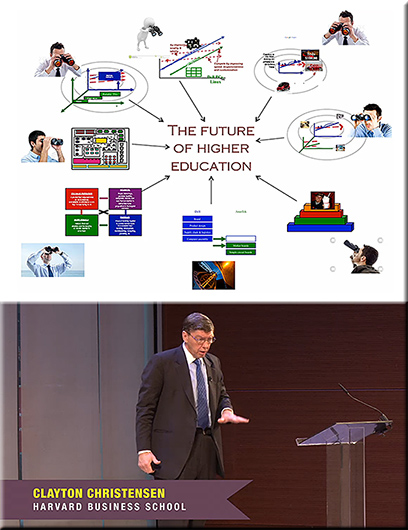“I actually don’t know any of the people you just mentioned . . .” — from Management & Strategy in Digital Higher Ed by Dr. Keith Hampson
Excerpt:
Colgate University hosted an event last week. “Innovation + Disruption Symposium“. The keynote was none other than Clay Christensen, the Godfather of Disruption Innovation. Following his talk, seven University Presidents of private universities fielded questions from the moderator.
…
But a few moments stood out; here’s my favourite. Clay Christensen – having done his bit on disruptive innovation in higher education – was sitting in the audience listening to the Presidents field questions. He rose and noted, half-jokingly, that everyone on the panel disagreed with everything he had just said about the coming disruption in higher education. Laughs ensued. He then asked the panel to imagine that a second panel was on stage with them. This second panel included the Founder of the Khan Academy, Paul Leblanc of Southern New Hampshire University, the President of Western Governors University, and others that are commonly believed to be leading the changes that are unfolding in higher education. Christensen asked the panel to consider what this second, imaginary panel might say that is different from what he had been hearing.
The response? David Oxtoby, President of Pomona College fielded the question: “I actually don’t know any of the people you just mentioned, but . . .”
You can’t make this stuff up. I don’t recall ever hearing or reading anything that so succinctly illustrates the existence of different worlds and perspectives within higher education.
Also see:
- Question of the day: How worried should higher education leaders be about the future? — from news.colgate.edu by Barbara Brooks on May 5, 2014
Excerpt:
After Clayton Christensen predicted that half of higher education institutions will either be facing bankruptcy or in liquidation within 10 to 15 years, six liberal arts presidents expressed varying degrees of concern, ranging from “not worried” (Georgia Nugent, president emeritus of Kenyon College) to “only the paranoid survive” (Colgate President Jeffrey Herbst).
From DSC:
I love Keith’s line: “You can’t make this stuff up.” Then later on in his posting, “Yet, the President of a university – having accepted an invitation to an event to talk about disruptive innovation in higher education – has not heard of many of the people behind these changes. Wow. Just wow.” Thanks Keith — right on!
My comment is this:
Too many presidents and those in leadership waaaay underestimate what can be done online. They didn’t grow up with many of the technologies we have today and, quite frankly, they aren’t sold on them. Nor have many of them taken an online course recently (or ever) themselves, I’d guess.They also have very vested interests in keeping things the way they are; they have to guard/craft their public-facing words very carefully.
Many leaders throughout higher education also neglect to highlight/mention/recognize that online learning doesn’t come with multimillion dollar, physical plant-related expenses. Online learning can be expensive, depending upon the level of sophistication one wants to achieve. However, there are no buildings to maintain. There are no elevators to fix. There are no lawns to mow. There are no sidewalks to repair. There are no heating bills. There are no lightbulbs/fixtures to maintain…walls to paint…etc., etc. Adding additional storage space or purchasing a new server is much more affordable than developing a new building. Online learning doesn’t care much about the buildings “arms race.”
So I wonder, how will face-to-face learning be able to compete in the future? Or…is that not even the question? Many have asked another question, “Will only the very wealthy be able to afford an on-campus experience?”









